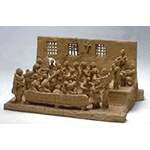Ex Ospedale Psichiatrico San Niccolò [Former San Niccolò Psychiatric Hospital]
Inaugurated in 1818 in the former monastery of San Niccolò in the vicinity of Porta Romana, suitably readapted to the purpose of accommodating mentally ill patients up to then housed in inadequate facilities, it numbered, at the time of its opening, 34 patients. The financial management of the institute was the responsibility of the Company of Disciplined Brothers Under the Hospital Vaults, later to become the Society of Executors of Devout Dispositions, which exercised its authority through a deputation of four "Brothers" having full power of management. Physicians too had to submit to this hierarchy, limiting their duties to "prescribing medicinals, baths, surgical operations and applications, and the variations that may be necessary in the hospital’s treatment as regards food and beverages", with the reservation that any change had to be authorised by the Society’s Deputies. Even the appointment of the director of the insane asylum was entrusted to the Company of Disciplined Brothers and not to the organs responsible for medical questions.
The first director was Giuseppe Lodoli, professor of Practical and Clinical Medicine at the University of Siena, who attempted to introduce into psychiatry new methods of treatment, in contrast to the repressive measures adopted up to that time. Decisive, in this sense, was the work of Carlo Livi (director from 1858 to 1873), who treated mental illness, contrary to the dominant opinion of the times, as a disease like any other to be treated by specialised physicians. A convinced believer in work as a means for curing the mentally ill, Livi organised San Niccolò like a village, made up of pavilions dedicated to work of various kinds: sewing and mending, carpentry, straw-weaving, working in the laundry, and the activities of shoemakers, smiths and agricultural workers. These occupations, in addition to their therapeutical scope, yielded financial returns that made the institution independent of the Company. In the first half of the 20th century the Psychiatric Village of San Niccolò was established, able to accommodate over 2,000 patients a year engaged in various kinds of work in its weaving and knitting workshops; from this there developed a real women’s industrial colony.
The hospital was also equipped with a scientific library and a pharmacy. The library, which in recent years has gone to enrich the heritage of the Siena Faculty of Medicine's Central Library, includes a vast number of works of medical interest, dealing mainly with psychiatric and neurological problems. The pharmacy, instead, built in 1885 in Pompeiian style to the design of the architect Francesco Azzurri, forms a little section of its own. Its shelves and furnishings have remained intact, while the laboratory in the back room has been dismantled.
The collection of medical objects from the former psychiatric hospital includes surgical instruments, medical apparatus and laboratory equipment from the 19th century.
****************************
Texts by Antonella Gozzoli
English translation by Catherine Frost
Last update 26/gen/2008




